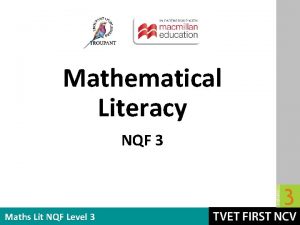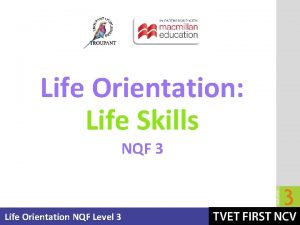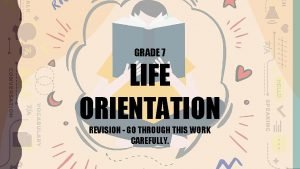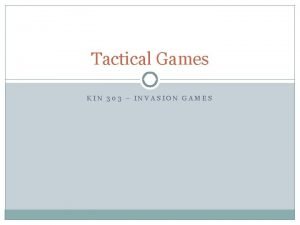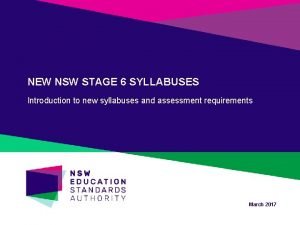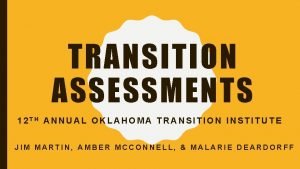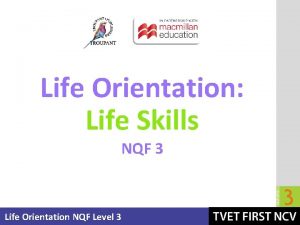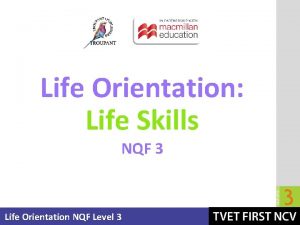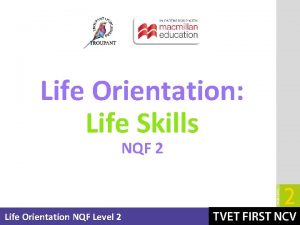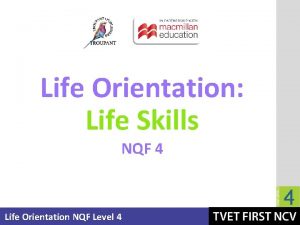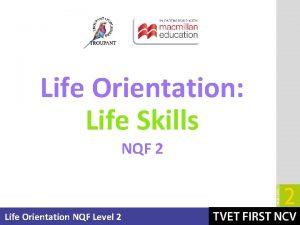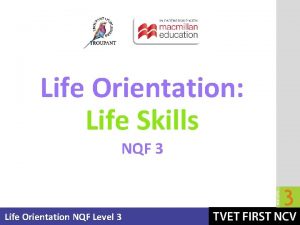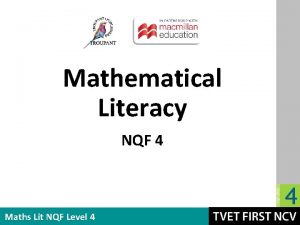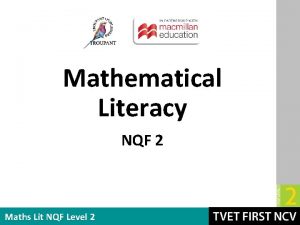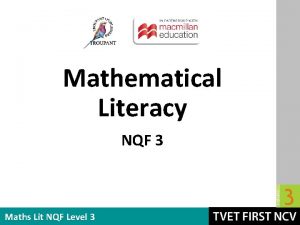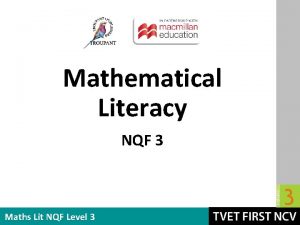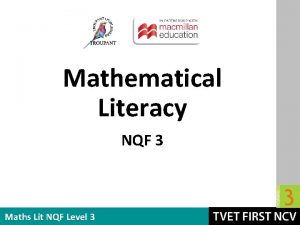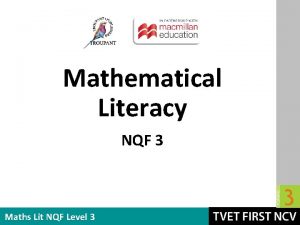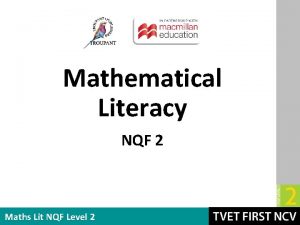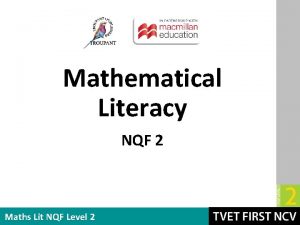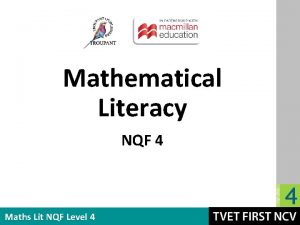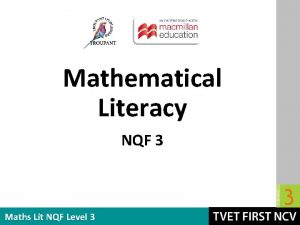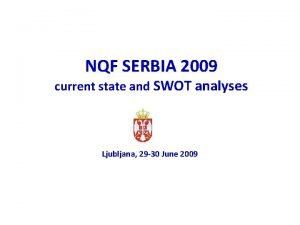Life Orientation Life Skills NQF 3 Life Orientation
























- Slides: 24

Life Orientation: Life Skills NQF 3 Life Orientation NQF Level 3

Apply learning & thinking skills & strategies in various contexts Module 6 *see terms and conditions

Think about it… • Can we exercise our mind & memory, or are we stuck with what we have? • Are there different methods for making decisions, or are we led by our emotions & circumstances? • What are creative ways of looking at problems that need to be solved?

Unit 6. 1 Mnemonic techniques Life Orientation NQF Level 3

What are mnemonic techniques? • Say: nee-mónick • A system to help you to remember a list or sequence • Example: making a special word, sentence, pattern of letters, or rhyme.

Mnemonic techniques for memory skills • Words: v Write down the first letter of each word in the list. v Use the letters to form a word. v Use the new word to create a mental picture of the concept. Figure 6. 2: The well-known mnemonic “Roy G. Biv” is a useful way to remember the order of the colours of a rainbow

Mnemonic techniques for memory skills • Sentences: v Form a sentence with the first letter/parts of words • Associations: v Link a fact or number to something else • Rhymes & tunes: v Use music & actions • Stories.

Module 6 Learning activity 6. 1 Test your knowledge of this unit – and use mnemonic techniques – by completing Learning activity 6. 1 in your Student’s Book. Life Orientation NQF Level 3

Unit 6. 2 Decision-making methods Life Orientation NQF Level 3

Decision-making methods • Every day, you need to make decisions. • You need to think through your choices. • Use different methods to avoid bad decisions.

Decision-making methods • Compare the pros & cons: v List advantages & disadvantages v Think long-term v Do what will be best for you in future, and not just now. Figure 6. 6: Making a list of pros and cons can help you to weigh up the positives and negatives about your decision

Decision-making methods • Weigh up alternatives: v Write down all options v Work out pros & cons. • Ask questions: v Write them down or talk them over v Answer the questions honestly v Think logically.

Decision-making methods • Find group consensus: v If the outcome affects others, talk through the options with them. • Seek outside advice from people: v Who you know & respect v Who aren’t affected by your decision (neutral) v Individually to get an unbiased response.

Module 6 Learning activity 6. 2 Test your knowledge of this unit – and practise decision-making methods – by completing Learning activity 6. 2 in your Student’s Book. Life Orientation NQF Level 3

Unit 6. 3 Problem-solving methods & creative thinking skills Life Orientation NQF Level 3

Conventional thinking methods • Identify the cause & effect. • Find the root cause (it may be deeper than you think). Figure 6. 12: Unfortunately, many “solutions” • Use reasoning. are only aimed at lessening the distress or pain of the symptoms, and don’t attend to or reach the root causes

Conventional thinking methods Table 6. 4: Types of reasoning Types Inductive reasoning Descriptions Observe statements or things that happen and then make generalisations (draw conclusions) based on your observations. In other words, go from the specific to the general. Deductive reasoning Make a generalised assumption (or theory or hypothesis) that you believe to be true and then set out to find observations to prove it. In other words, go from the general to the specific. Critical thinking Analyse and examine a problem in detail – all its components, pros and cons, and all arguments and claims around it. Establish the facts and weigh up all evidence before reaching a judgement. Conditional thinking Explore your options in a given or anticipated problem situation. The leading phrase in each case can be: “If I do this, or choose this option (or if this happens), then. . . ”, as well as the words “but (however). . . ” and “therefore. . . ”.

Module 6 Learning activity 6. 3 Test your knowledge of this section by completing Learning activity 6. 3 in your Student’s Book. Life Orientation NQF Level 3

Unconventional thinking methods • Creative thinking = thinking beyond the obvious • Doesn’t follow established patterns of thought • Generates new ideas • Allows for innovation.

Unconventional thinking methods • Think creatively: v Look through other lenses v Brainstorm. • Think laterally (from another angle) • Generate innovative ideas: v Combine facts to form a new concept v Find new uses for familiar objects v Make random associations v Use whole brain thinking.

Unconventional thinking methods Thinking style Analytical Sequential Interpersonal Imaginative Table 6. 5: Herrmann’s styles of thinking Description Examples Logical, technical, critical Structured, planned, detailed Emotional, spiritual, feelings Intuitive, visual, conceptual Collecting data; analysing it; reasoning logically; evaluating facts Organising; solving problems step by step; following directions Sensory input; group interaction; expressing ideas; listening Problem-solving; taking the initiative; enjoying visuals; looking at the big picture of things

Module 6 Learning activity 6. 4 Test your knowledge of this section – and practise unconventional thinking skills – by completing Learning activity 6. 4 in your Student’s Book. Life Orientation NQF Level 3

Summative assessment Portfolio task 1 Complete Portfolio task 1 in your Student’s Book. This is a formal test. Life Orientation NQF Level 3

Mathematics NQF Level 2 Life Orientation (Life Skills) NQF Level 3
 Mathematical literacy nqf level 3
Mathematical literacy nqf level 3 Nqf level 5
Nqf level 5 Labour intensive construction training nqf 5
Labour intensive construction training nqf 5 Life orientation skills
Life orientation skills Geocentric polycentric ethnocentric
Geocentric polycentric ethnocentric How to improve intrapersonal skills
How to improve intrapersonal skills Skill
Skill Ontario skills passport essential skills
Ontario skills passport essential skills Memorandum of social and environmental responsibility
Memorandum of social and environmental responsibility Life orientation grade 8
Life orientation grade 8 Democracy and human rights life orientation
Democracy and human rights life orientation Accountability definition in life orientation
Accountability definition in life orientation Life orientation grade 7 june exam
Life orientation grade 7 june exam Life orientation grade 7 self image
Life orientation grade 7 self image Types of stress in life orientation
Types of stress in life orientation Life orientation grade 7 term 2 exam papers
Life orientation grade 7 term 2 exam papers Life skills stress management
Life skills stress management Life skills e competenze chiave
Life skills e competenze chiave English life skills stage 6
English life skills stage 6 Hfle pictures
Hfle pictures Differenza tra competenze chiave e life skills
Differenza tra competenze chiave e life skills Characteristics of life skills
Characteristics of life skills Generic life skills
Generic life skills Caseys life skills
Caseys life skills Casey life skills assessment scoring
Casey life skills assessment scoring
